Published
on 19
May 2015
|
All rights reserved.
|
|
|
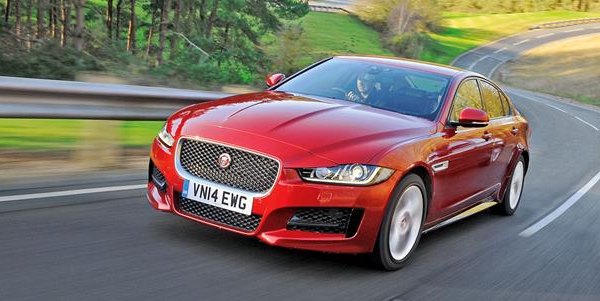
|
Undoubtedly, XE is
the most ambitious project taken by Jaguar since the unsuccessful X-Type. It intends to lift Jaguar from a
niche brand to a mass production premium brand like BMW, Audi and
Mercedes. To this end Jaguar Land Rover invested heavily into an
all-new aluminum platform and Ingenium 4-cylinder engines, as well as
to modernize the Land Rover Solifull plant for its production. The new
assembly lines have a maximum capacity of 180,000 units a year. If
everything goes according to plan, the XE sedan and its sportwagon
variant will occupy about half the capacity, while the remaining will
go to a new compact SUV (F-Pace) that is to be derived from the same
platform. By 2018, the company is expected to build 230,000 vehicles a
year, a 3-fold increase from last year's 80,000 units. Therefore, the
XE project is a big gamble to JLR.
Bearing so much pressure, it is understandable that design chief Ian
Callum played safe this time around. The XE lacks the creativity and
wow factor of XF, which is probably the most beautiful sedan presently.
Although its face is still easily recognizable as a Jaguar, the rest of
the body is not remarkably different from a BMW 3-Series. Compared with
the BMW, it might be slightly sportier, with a slightly longer, wider
and lower proportion as well as faster windscreen and rear window, but
given the more restricted dimensions and the need to provide adequate
interior space, it could not get as sleek as we expected. The nose and
bonnet are the squarest among the current generation of Jaguars.
Although they don’t affect aerodynamics, whose drag coefficient is a
highly competitive 0.26, they lose the aesthetic for which modern
Jaguars are famous. To me, it's a slight disappointment and a missed
opportunity.
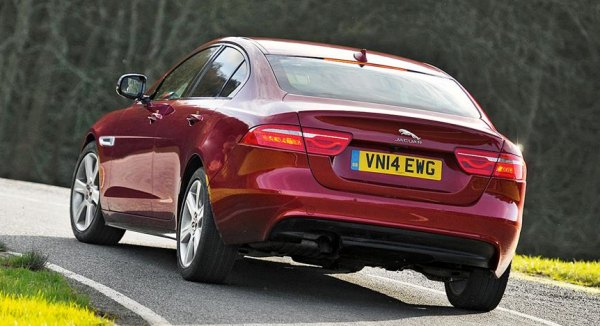
|
The baby Jaguar runs a 2835 mm-long wheelbase, exceeding BMW 3-Series
by 25 mm. However, its cabin space is slightly tighter, because its
aluminum construction is inevitably more
space-engaging than the high-strength
steel construction of BMW. Yes, the Jaguar is the first mass production
D-segment saloon to employ a chassis largely made of aluminum. Some 75
percent of the monocoque is this lightweight material,
compared with 48 percent in the case of Mercedes C-class. The dashboard
cross-beam is made of magnesium (a popular solution seen on many cars),
while the remaining is steel, including the rear floorpan, boot lid and
doors. These help achieving a 50:50 front-to-rear balance on the
lighter
petrol 4-cylinder model (or 53:47 for supercharged V6). As usual,
Jaguar's aluminum chassis uses rivets and adhesive bonding to
join aluminum parts together, unlike Audi which prefers welding.
Progress in manufacturing technology allows the bonding time on each
station to be reduced from 210 to 78 seconds compared with the XJ.
Despite that, the XE does not show any weight advantage over its
rivals. For example, an XE with 2.0 turbo petrol engine and automatic
transmission is 5 kg and 55 kg heavier than a BMW 328i auto and
Mercedes C250 respectively. The gap between XE S with supercharged V6
and BMW 335i auto is even wider at 70 kg. Why does it not shine on the
scale? Part of the cause is its high-spec suspensions. While its rivals
employ MacPherson struts up front and mulit-link setup at the rear, the
XE opted for more sophisticated double-wishbone suspensions up front
and so-called "Integral link" rear suspensions. The double-wishbone
front suspension is derived from F-Type sports car. It is preferred
over MacPherson struts because the steering is less affected by
suspension setup thus
improves steering precision and feel. The “Integral link” rear
suspension consists of a knuckle, a lower control arm, an upper camber
link, a vertical toe-control link and, most special, a short vertical
integral link. The last one helps separating lateral cornering
forces from vertical forces, thus enables the use of 30% softer
vertical
bushings for better ride quality and harder lateral bushings for better
handling. Besides, the suspensions employ dual-raised springs, whose
spring rate increases as they compress, so to provide a softer initial
impact absorption and harder roll resistance under stress.
Theoretically, its more sophisticated suspensions should
bring better ride and handling combo than its rivals (we shall see
later on). As expected, most of the suspension components are made of
aluminum to save unsprung weight. Bilstein adaptive dampers are
standard on XE S or optional on lesser models.

|
For steering, the XE is the first Jaguar to employ electric power
steering. Like its German rivals, it’s an ZF system with rack-mounted
motor, but Jaguar’s engineers invested a lot of time on its software
tuning to find the optimal setting.
Jaguar made a lot of noises about its new Ingenium family of 2.0-liter
turbocharged petrol and diesel 4-cylinder engines (sounds like Volvo's
Drive-E). However, at the launch of XE only the diesel is ready. Its
design is thoroughly modern, if not groundbreaking. It features
aluminum head and block, vibration-reducing balancer shafts,
friction-reducing roller bearings on camshafts and balancer shafts,
on-demand coolant and lubrication pumps, acoustically damped solenoid
injectors and emission-cutting variable exhaust valve timing. The lower
tuned version, rated at 163 hp and 280 lbft of torque, achieves an
incredible 74 mpg combined and CO2
emission of 99 g/km when mated with the new ZF 6-speed manual gearbox,
thus is extremely tax friendly. The higher power version produces 180
hp and 317 lbft. It’s not as green though, at 109 g/km, when mated with
either the manual or ZF 8-speed automatic.
Before the petrol version of Ingenium arrives, the XE employs Ford’s
2.0-liter Ecoboost engine with 240 hp, as found on Mondeo/Fusion.
Meanwhile, the 335i-rivalling XE S is powered by the same 340 hp
3.0-liter supercharged V6 that serves the base F-Type. It is capable to
sprint from 0-60 mph in 4.9 seconds and top a regulated 155 mph.
On the Road
Open the doors, you will find a modern interior design and up-to-date
touchscreen infotainment system. As in XJ, the whole dashboard
architecture is recessed below the shoulder line to deliver a sportier
and airier feel. It is more stylish than BMW 3er, if not Mercedes
C-class or Lexus IS. The steering wheel and center console look classy,
ditto the now famous rotary gear selector (for the auto). The perceived
quality is high, but ultimately it can’t quite match the consistency of
BMW or the outstanding quality standard of Mercedes (the next Audi A4
is sure to beat it, too). You can find some cheaper plastics or leather
at less significant places, while some switches do not operate with the
same quality feel of its German rivals. The touchscreen is clear and
its software is responsive, but without a hardware control knob like
i-Drive or Comand it is inevitably more difficult to access while the
car is moving.
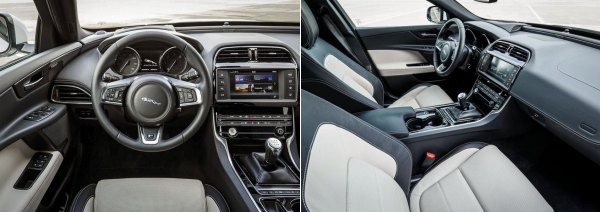
|
Space-wise, the Jaguar is fine for front occupants and less so for rear
passengers, as headroom is limited by the swooping roof line.
Shoulder room and legroom are also a bit tighter than the BMW. The same
story can be said for the boot, which measures 450 liters only, or 30
liters less than BMW and Mercedes.
If the XE can’t beat its rivals in cabin comfort, it must win in
driving dynamics. Fortunately, this is exactly the case road testers
found out. This car is really an all-rounder. It corners as good as
Cadillac ATS (that means better than BMW), and simultaneously rides as
refined as Mercedes. The sophisticated suspension and steering tuning
pays off. Although adaptive dampers offer a wider scope of usage, it
doesn’t need them to shine. The passive suspensions are already good
enough. There are 2 passive setups to choose from, one softer and one
stiffer. Either way, the driving character is not vastly different. The
XE is always eager and responsive to turn. The nose feels pointy and
the front tires seem to offer remarkable grip. The electric steering is
light yet precise and consistently loads up in corners. It is not truly
feelsome, but when the car reacts so keenly to the steering you can
forget about that. The XE is also very well balanced in corners, but
most impressive is its outstanding composure, thanks to a firm but
surprisingly supple ride. The suspension does a great job to iron out
road irregularities and bumps, keeping the body stable in corners and
allowing you to exploit its excellent balance and grip. Small premium
sedans have never been so fun to drive and so versatile.
The Ingenium 2.0-liter diesel offers decent power and good refinement
by class standards. On the one hand there’s little diesel clatter on
the startup, on the other hand the engine settles to a smooth whisper
when cruising on highway. Refinement is also aided by low level of wind
noise. The 6-speed manual gearbox paired with the diesel is a little
disappointing, blame to a long throw and slightly imprecise gearshifts.
Comparatively, the ZF 8-speed automatic is near perfect. Its gearshift
is smooth and responsive, nearly as good as the installation on BMW.

|
Although the Ford-sourced 2.0 petrol turbo is only an interim solution,
it is still a highly competitive engine. Its 240 horsepower enables a
performance brisk enough, while its refinement at high rev is clearly
superior to the Ingenium diesel. It revs smoothly and willingly. I
wonder how much the forthcoming Ingenium petrol could improve on it.
The XE S with supercharged V6 doesn’t feel as quick as its 0-60 mph
time of 4.9 seconds suggested. On paper, its maximum output of 340 hp
beats BMW 335i’s 306 hp, but perhaps due to its more linear power
delivery or the additional weight it carries, it feels slower than the
BMW. That said, for a 90-degree V6 it is pleasantly smooth, and the
exhaust note is pretty delicious, not troubled by supercharger whine.
The problem is, this car is considerably pricier than its rival.
As a whole, the 3-Series is still a more complete car, offering more
space, slightly better interior build, equipment and a stronger engine
lineup. Mercedes C-class is perhaps more stylish and finished with
higher quality. The Jaguar beats them on driving dynamics. It's not
perfect, but what it has accomplished is already remarkable enough to
wash away the memory of X-Type and puts it at a strong market position.
|
Verdict:      |
Published
on 7
Jun 2018
|
All rights reserved.
|
|
XE SV Project 8
|
|
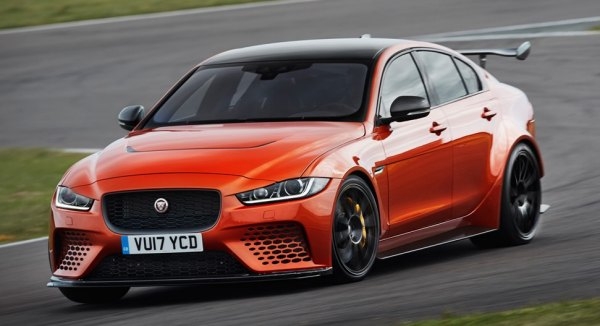
|
|
It
is not only the most powerful in its class but also the most powerful
production Jaguar ever...
|
|
A compact saloon fitted
with the largest engine possible. We have seen many AMG C-class since
the 1997 C43 (the first V8 in its class) up to the mighty 6.3-liter
model, but this Jaguar offers even more: a 5-liter supercharged V8
accompanied with 4WD system. It is not only the most powerful in its
class but also the most powerful production Jaguar ever, with 600
horsepower on offer. That’s 25hp more than the same engine serving
F-Type SVR and XJR 575, thanks to modified induction and exhaust. Big
engine, small car, must be very fast. Yes, it is very fast indeed. Top
speed is a neat 200 mph, while 0-60 takes 3.3 seconds. The V8 is mated
to the usual ZF 8-speed automatic, but it is remapped to shift faster.
Apart from powertrain, the car features many other modifications as
well. To accommodate the big engine and its cooling parts, the nose has
been extended slightly. To accommodate the 305/30ZR20 Michelin PS Cup
2s, wider fenders are adopted. The bonnet, fenders, boot lid and
bumpers are made of carbon-fiber, as is the adjustable rear wing and
diffusers. Pronounced front splitter and flat underbody contribute
further to downforce, which amounts to 122 kg at 186 mph.
The suspension is also overhauled with new knuckles made of machined
billet, racing-style lightweight ceramic wheel bearings and (manually)
adjustable springs for 2 ride heights – the lower of which is obviously
designed for track. Front and rear tracks have been widened by 24mm and
73mm, respectively. Continuous adaptive dampers are retained but the
springs are 4.5 times stiffer than those of the regular XE. The rear
subframe is rigidly mounted. The rear upper
control arms switch to rigid ball-joints, while other bushings get
stiffer. Unsprung weight is cut by the aforementioned ceramic bearings,
20-inch forged alloy wheels and standard fitted Brembo carbon ceramic
brakes. Mind you, the tires are Michelin PS Cup 2s, like many supercars.
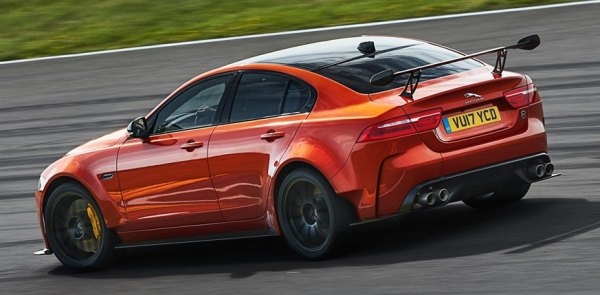
|
|
It
keeps gripping, gripping and gripping...
|
|
Now it goes without saying the SV Project 8 is not just a hotter
version of XE in the same breath of M3 or C63 or RS4. Built by the SVO
(Special Vehicle Operation) and limited to 300 units worldwide, it is
actually an extreme road and track car, more so than the M4 GTS I would
say. It might be strange to see it as an alternative to 911 GT3 RS, but
Jaguar is not shame to say so. Otherwise, it would not have offered a
Track pack that turns the front seats to carbon-fiber racing buckets
and replaces the rear seats with a half-roll cage, saving 12kg in the
process. The pack costs £10,000 extra, but it sounds nothing
compared with the car’s base price of £150,000, which is even
harder to swallow than the £120,000 price tag of M4 GTS (whose
production has finished, by the way). In fact, it is more
expensive than bespoke sports cars like Audi R8 V10 Plus, Porsche 911
Turbo S, McLaren 570S and the 911 GT3 RS. A new 911 GT3 at
£110,000 sounds
bargain next to it.
So how does it perform on track? Does it have the measure of a GT3
RS?
Not quite, of course. The supercharged V8 has a linear and responsive
manner not unlike that of the naturally aspirated Porsche. It offers
significantly more torque low down, but the flipside is a tamer top
end, as its rev is limited to 6500 rpm. The V8
soundtrack through the titanium exhaust is as loud and raw as a race
car's. For a car capable of 0-60 in 3.3 seconds, the
ZF automatic seems a little lazy. Gearshift is not quite
as quick and incisive as the rivalling DCTs, so the latter remain
safe in the supercar world. The Project 8 is undeniably powerful, but
hauling its ridiculous 1745 kg kerb weight it feels suitably fast
rather
than explosively so. A GT3 needs not to fear.
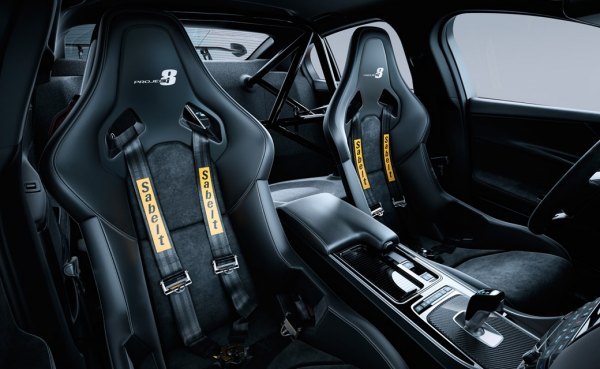
|
|
if
you can pay so much money for a track car, why do you want a
heavyweight saloon instead of a thoroughbred junior supercar?
|
|
Surprisingly, installing a heavyweight engine into a compact chassis
does not result in poor balance or endless tire-smoking moments. In
fact, the handling is exceptionally good for a performance saloon, more
so than anything else we can think of – Alfa Giulia QF might be close,
but it is not quite as extreme. The fact that it lapped Nurburgring in
7min 21sec, 7 sec faster than M4 GTS and 11 sec less than Giulia QF,
shows how good it steers, balances, grips and stops, despite that
excessive weight. Its rear-biased 4WD system (taken from F-Type SVR
AWD) does not corrupt the XE’s faithful steering. It works in
conjunction with the Cup 2 tires to offer incredible roadholding, Even
on a track you need to push it extremely hard to see its limit of
adhesion. The nose of the car turns with swiss watch precision.
Understeer is almost non-existent. Tuned to optimize track performance,
it is not prone to oversteer either, unlike an M5 or E63 S. It keeps
gripping, gripping and gripping. It feels very stable and predictable
until its extremely high limits, by then it will most likely
demonstrate a rally-style 4-wheel drift before regaining traction. The
body control is exceptional, too, with almost no roll to speak of. This
is a precise driving tool, a race car in saloon clothes. No other
performance saloons come close to its handling. Admittedly, none of
them are so close to a track car in design.
What about its ride quality and refinement? Well, the suspension is
certainly stiff, but the damping is effective enough to make back roads
livable. It feels a match for the GT3, and more comfortable than a GT3
RS for daily road use. Less tiring to your ears as well.
Nevertheless, if you can pay so much money for a track car, why do you
want a heavyweight saloon instead of a thoroughbred junior supercar? As
quick as the Project 8, it is no match for a GT3 (7:12.7 in
Nurburgring), let alone a GT3 RS (6:56.4). The same for driver
engagement and sheer desirability, too. Driving next to them you can
feel the weight of Jaguar as well as the limitation of its gearbox. In
isolation it is a big achievement to the SVO division, but nothing at
this price level deserves less.
|
Verdict:    |
Published
on 16
Jul 2018
|
All rights reserved.
|
|
XE 300 Sport
|
|

|
|
Can
a 300hp 4-cylinder fill the vacancy left by supercharged V6?
|
|
In
Europe, Jaguar has quietly killed off the supercharged V6 from the
lineup of XE and XF (it still lives elsewhere, and now in 380hp form),
blame to the new WLTP test cycle adopted by EU, which would have pushed
its corporate CO2 emission level too
high. While the larger XF has the very powerful diesel V6 to fill up
the gap, the smaller XE has no choice but to introduce a more powerful
version of its Ingenium four-cylinder petrol engine. In fact, this
engine was already available to F-Type last year. It is rated at 300hp
and 295 lbft, outstanding for a mass production 2-liter. For
comparison, the most poweful alternatives from BMW and Audi manage only
252hp. The new Mercedes M264 engine produces 299hp, but it is not going
to be available to the C-class any time soon. This means, the closest
rival to Jaguar will be Alfa Romeo Giulia Veloce, whose 2.0 MultiAir
Turbo provides 280hp and 295 lbft. Consequently, the XE 300 Sport
offers class-leading performance, with 0-60 mph done in a claimed 5.4
seconds. These days you should not underestimate four-cylinder engines.
The 300hp Ingenium engine has one additional feature not found on its
250hp sister: a sophisticated variable valve lift system. Its mechanism
is somewhat copied from Fiat's MultiAir. The intake camshaft does not
actuate the valves directly. Instead, each cam lobe acts on a roller
finger follower which pushes a small hydraulic pump. The latter pumps
oil to push the intake valve. At the other end of the oil path, there
is an oil chamber with integral solenoid valve. When the solenoid valve
is closed, the oil cannot enter the chamber, thus it flows straight to
the valve actuator and realizes the maximum valve lift (11mm).
Conversely, when the solenoid valve is opened, oil enters the chamber
instead of pushing the valve actuator, resulting in zero lift or a
complete valve closure. By controlling the timing of the solenoid valve
opening, the engine can achieve fully variable valve lift. It goes
without saying that the addition of VVL to DVVT improves torque spread
further. The engine produces peak torque from 1500 to 4500 rpm, even
though it achieves a high specific output of 150hp per liter.
Moreover, the Ingenium employs DOHC, unlike the SOHC MultiAir. This
allows it to rev higher and produces more top end power. Not just
power, the VVL also cuts fuel consumption by regulating the engine
output in place of throttle butterfly, like BMW Valvetronic.

|
|
New
Jaguar engine features MultiAir-style variable valve lift system
|
|
Enough theories. In reality, it is a little disappointing to find the
XE 300 Sport not quite as fast as expected. The car's hefty, 1615kg
kerb weight is mostly to blame, but it might be also due to the
engine's lack of character. Its power delivery is linear to the extent
of unexciting. Its exhaust note is also too quiet to stir your soul.
Don't assume it as a direct rival to BMW 340i or Audi S4. Those
six-cylinder rivals feel much faster and, especially in the case of
BMW, plays musical exhaust notes. What the Ingenium succeeds is that it
doesn't feel too rough beside a six-cylinder.
Admittedly, part of the weight is contributed by the standard-fitted
AWD system. I guess the 300 Sport would have been more agile with RWD,
but Jaguar considered AWD to be more adequate to manage 300hp, even
though we never thought a 340i wanting xDrive. On the plus side, the
Jaguar has retained all the merits of the outgoing XE S, with a
class-leading steering and impeccable combination of ride and control.
If anything, it feels even more agile than the V6 model, thanks to the
34kg weight saving over its front axle.
That said, without a stronger engine it is still not good enough to
compete with 340i, especially when the Jaguar is embarrassingly more
expensive to buy. Yes, it has a better chassis, unquestionably, but
will you pay more for fewer cylinders? Cost is still the biggest
headache of JLR.
|
Verdict:     |
|